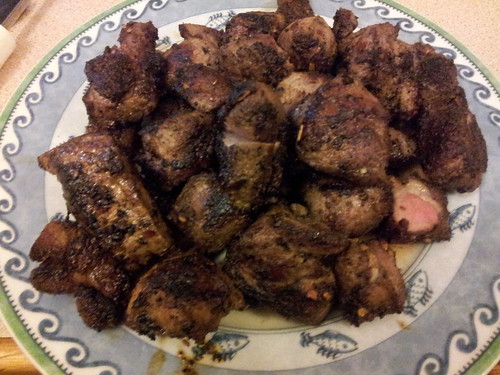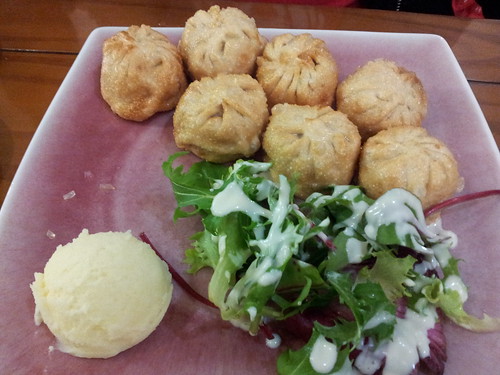A super quick and easy recipe that I’ve had earmarked for ages. This lamb recipe is perfect for the BBQ – so definitely keep it in mind as the weather warms up.
The recipe comes from the New Zealand Herald, and I had no idea who/where/what Xinjiang is. It transpires that it’s a region in north west China that’s home to many ethnic groups, but the Uyghur make up roughly 45% of the mix. Given how much we enjoyed the food at Tangritah Uyghur back in 2010 (hmmm, really must go back there), it’s no surprise that we both thought this recipe was top notch.
You do need to start this a day ahead, to give the lamb time to marinate. But other than that, this is insanely easy and quick.
Begin with approximately 1kg of lamb shoulder, cut into bite sized cubes. In a bowl, mix 2 tbsp ground cumin, chilli flakes to taste (the recipe calls for 1 tbsp, but perhaps the chilli flakes in NZ aren’t quite as hot as they are here …), 1 tbsp of black pepper (freshly ground is always best), 2 tsp of ground ginger and, if you have it, 1 tsp of ground Sichuan pepper. We couldn’t track this down in a hurry (which means the supermarket didn’t stock it) so left it out and I don’t think we missed it at all. Perhaps with it dinner would have tasted even better!
Add 4 tbsp of peanut oil, 4 tbsp of soy sauce, 4 cloves of garlic, minced, and salt to taste. Toss the lamb through the marinade, ensuring every piece is well covered and then refrigerate overnight.
The recipe is a bit more exacting about what to do and the order in which to do it. I had already cut up the meat and dumped it in a bowl, and Andy just mixed all the marinade ingredients through the meat – so assemble it whatever way suits.
If you’re going for the kebab look, soak bamboo skewers in water for at least an hour and then thread on the lamb and grill. We couldn’t be bothered and were going to just BBQ it until we discovered we were out of gas! So we ended up pan frying the lamb – which worked a treat except you do need an industrial strength extractor fan, otherwise your house will end up smelling like a lamb frying factory.
We served the lamb with spicy fried potatoes and some steamed vegetables. It would work just as well in a wrap with a yoghurt sauce, or served with a couscous salad.
We had a ton of leftovers (although not as much as you might expect!) and it turns out that the meat is almost as delicious, the next day, straight from the fridge!




